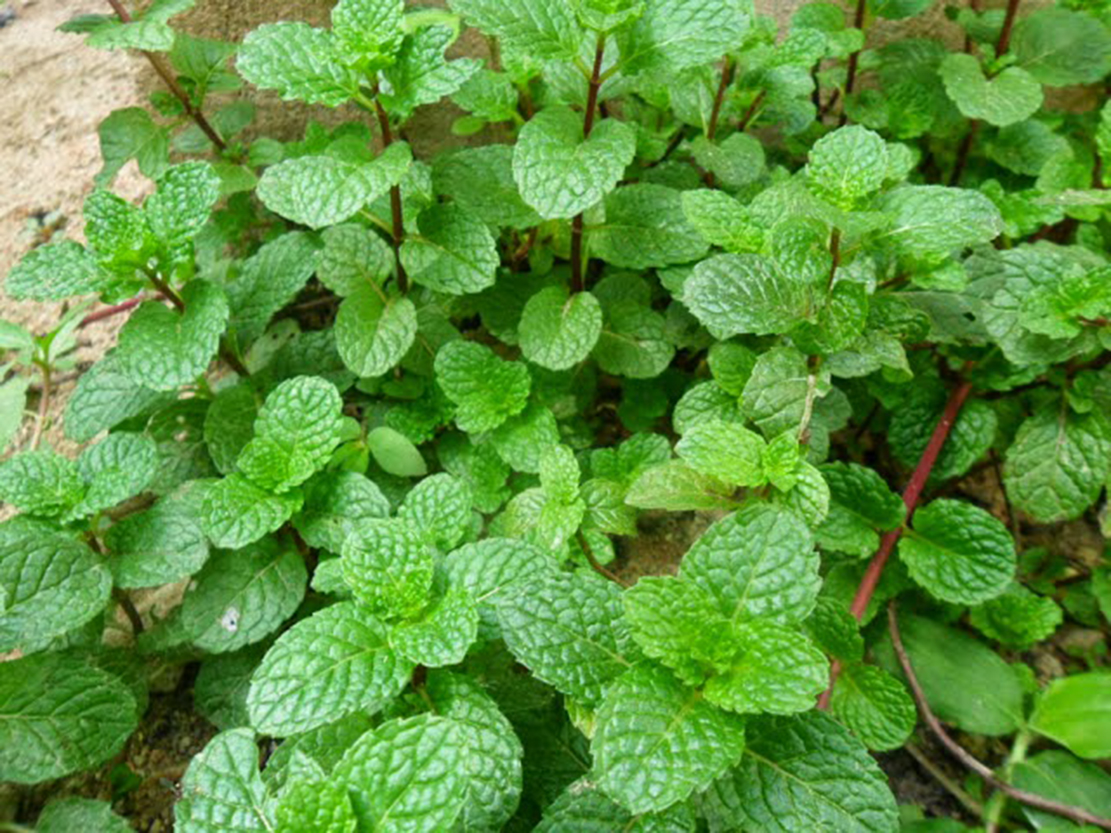ເລກລຳດັບທີ: 1453
ລະດັບການຮວບຮວມຂໍ້ມູນ: ຂໍ້ມູນພື້ນຖານ
ປັບປູງຄັ້ງລ່າສຸດ: N/A
ຫອມລາບ
Marsh Mint
Mentha villosa Huds
ພືດ
ພືດລົ້ມລຸກ
×
ຊື່ທ້ອງຖີ່ນ:
Thai: ສະຣະແໜ່
Eng: Kitchen Mint, Marsh Mint ( Thai: ສະຣະແໜ່
Eng: Kitchen Mint, Marsh Mint)
ຊື່ພ້ອງ
:
Mentha × alopecuroides var. lamarckii (Ten.) Rouy
Mentha × alopecuroides var. microdonta (Briq.) Rouy
Mentha × amaurophylla Timb.-Lagr.
Mentha × amaurophylla var. rugosa (Gadeceau) Rouy
Mentha × benthamiana Timb.-Lagr.
Mentha × billotiana Déségl. & T.Durand
Mentha × bolzanensis Heinr.Braun
Mentha × chloreilema (Briq.) Heinr.Braun
Mentha × chlorostachya Gand. ex Heinr.Braun
Mentha × controversa Pérard ex Heinr.Braun
Mentha × cordifolia Opiz ex Fresen.
Mentha × dossiniana Déségl. & T.Durand
Mentha × dumortieri Déségl. & T.Durand
Mentha × emarginata Rchb.
Mentha × floccida Déségl.
Mentha × genevensis (T.Durand ex Déségl.) Déségl. & T.Durand
Mentha × gillotii Déségl. & T.Durand
Mentha × gratissima Weber
Mentha × incanescens Heinr.Braun
Mentha × lamarckii Ten.
Mentha × alopecuroides var. microdonta (Briq.) Rouy
Mentha × amaurophylla Timb.-Lagr.
Mentha × amaurophylla var. rugosa (Gadeceau) Rouy
Mentha × benthamiana Timb.-Lagr.
Mentha × billotiana Déségl. & T.Durand
Mentha × bolzanensis Heinr.Braun
Mentha × chloreilema (Briq.) Heinr.Braun
Mentha × chlorostachya Gand. ex Heinr.Braun
Mentha × controversa Pérard ex Heinr.Braun
Mentha × cordifolia Opiz ex Fresen.
Mentha × dossiniana Déségl. & T.Durand
Mentha × dumortieri Déségl. & T.Durand
Mentha × emarginata Rchb.
Mentha × floccida Déségl.
Mentha × genevensis (T.Durand ex Déségl.) Déségl. & T.Durand
Mentha × gillotii Déségl. & T.Durand
Mentha × gratissima Weber
Mentha × incanescens Heinr.Braun
Mentha × lamarckii Ten.
ຊື່ສະກຸນ:
Lamiaceae
ຊະນິດໃກ້ຄຽງ:
ບັນຍາຍລັກສະນະທາງພືດສາດ:
ຜັກຫອມລາບມີລັກສະນະເຄິ່ງລໍາຕົ້ນເຄິ່ງເຄືອ, ມີຮາກຝອຍຂະໜາດໜ້ອຍ ແລະ ສັ້ນ, ລໍາຕົ້ນສູງ 15-30 ຊມ, ລໍາຕົ້ນມີລັກສະນະເປັນຫຼ່ຽມ, ຜິວລໍາຕົ້ນມີສີແດງອົມມ່ວງຈົນເຖິງປາຍຍອດ, ລໍາຕົ້ນສາມາດແຕກກີ່ງງ່າໃໝ່ຈົນຂະຫຍາຍເປັນກໍໃຫຍ່ ແລະ ລໍາຕົ້ນແຕກກິ່ງຂະແໜງຈໍານວນຫຼາຍ. ໃບດ່ຽວ ແລະ ອອກເປັນຄູ່ໆ, ກົງກັນຂ້າມກັນເທິງກິ່ງລໍາຕົ້ນ, ໃບເປັນສີຂຽວຮູບຊົງຣີ, ກວ້າງ 1.5-3.5 ແລະ ຍາວ 2-7 ຊມ. ຜິວໃບຍົ່ນເປັນລູກຄື່ນ, ຂອບໃບຍັກ, ປາຍໃບມົນ ຫຼື ແຫຼມ. ອອກດອກເປັນຊໍ່, ເທິງຊໍ່ໃບບໍລິເວນປາຍຍອດ, ແຕ່ລະຊໍ່ມີດອກຈໍານວນຫຼາຍ, ດອກມີສີບົວອົມມ່ວງ, ມີກີບລ້ຽງ 5 ກີບ ແລະ ກີບດອກເຊື່ອມຕິດກັນເປັນກວຍຕື້ນ 4 ກີບ ພາຍໃນດອກມີເກສອນຜູ້ 4 ອັນ ສ່ວນເກສອນແມ່ບໍ່ຄ່ອຍພົບ. ມີໝາກເປັນສີດໍາ, ມີຂະໜາດນ້ອຍ, ມີລັກສະນະເປັນຮູບກະສວຍ, ເປືອກໝາກກ້ຽງມັນ, ທັງນີ້ໝາກຫອມລາບບໍ່ມັກຕິດເພາະສ່ວນໃຫຍ່ດອກເປັນໝັນ.
ນິເວດວິທະຍາ
ເຂດກະຈາຍພັນທົ່ວໂລກ:
N/A
ເຂດກະຈາຍພັນໃນລາວ
:
ເຂດກະຈາຍພັນຕາມພູມສັນຖານ
:
ສະເພາະຖິ່ນໃນລາວ:
N/A
ຮຸກຮານ
:
N/A
ສະຖານະພາບການອະນູຮັກ IUCN
:
N/A
ສະຖານະພາບການອະນຸຮັກແຫ່ງຊາດລາວ
:
N/A
ການນຳໃຊ້
ປະເພດການນຳໃຊ້:
ອາຫານ
ພືດເປັນຢາ
ພືດເປັນຢາ
ບັນຍາຍການນຳໃຊ້:
ປະໂຫຍດ ແລະ ສັບພະຄຸນ:
- ໃບອ່ອນ/ຍອດອ່ອນຫອມລາບໃຊ້ຮັບປະທານເປັນຜັກກິນກັບອາຫານປະເພດລາບ, ເຝີ, ຊຸບໄກ່ ເປັນຕົ້ນ.
- ໃບສົດນໍາມາບີບເພື່ອສູດດົມຈະໄດ້ກິ່ນຫອມນໍ້າມັນລະເຫີຍ ຊ່ວຍໃຫ້ສົດຊື່ນແກ້ອາການວີນຫົວ.
- ນໍາໃບສົດມາລ້າງນໍ້າແລ້ວໄປຕາກແຫ້ງ 5-7 ແດດສໍາຫຼັບໃຊ້ຊົງເປັນຊາດື່ມ.
- ຊ່ວຍໃຫ້ຜິວຊຸ່ມຊື່ນດ້ວຍການນໍາເອົາໃບຫອມລາບມາບົດແລ້ວທາຜິວ.
- ຊ່ວຍບໍາລຸງ ແລະ ຮັກສາສາຍຕາ.
- ຊ່ວຍແກ້ອາການໜ້າມືດຕາລາຍ ດ້ວຍການດື່ມນໍ້າຕົ້ມໃບຫອມລາບກັບຂີງ.
- ຊ່ວຍລະງັບກິ່ນປາກໄດ້.
- ຊ່ວຍຂັບລົມໃນລໍາໄສ້ ແລະ ຊ່ວຍໃນການຍ່ອຍອາຫານ.
- ກິ່ນຂອງໃບຫອມລາບຊ່ວຍໃນການໄລ່ຍຸງ ແລະ ແມງໄມ້ຕ່າງໆ ດ້ວຍການນໍາໃບມາບົດແລ້ວນໍາມາທາຜິວ.
- ໃຊ້ແຕ່ງກິ່ນເຄື່ອງດື່ມຕ່າງໆ ແລະ ເຫຼົ່າໄດ້.
- ນໍາໄປໃຊ້ເຮັດເປັນນໍາມັນຫອມລະເຫີຍເພື່ອໃຊ້ເຮັດການບໍາບັດດ້ວຍກິ່ນ.
ການປູກ ການລ້ຽງ:
N/A
ລະດູການເກັບກູ້:
ການຕະຫຼາດ ແລະ ຕ່ອງໂສ້ມູນຄ່າ:
N/A
ການຄຸ້ມຄອງຈັດການ
N/A
ໂພຊະນາການ
ຄຸນຄ່າທາງໂພຊະນາການ:
ບັນຍາຍຄຸນຄ່າທາງໂພຊະນາການ:
N/A
| ສານອາຫານ | /100g | ໝາຍເຫດ |
|---|---|---|
| ໂປຣຕີນ | N/A | N/A |
| ຄາໂບໄຮເດຣດ | N/A | N/A |
| ໄຂມັນ | N/A | N/A |
| ວິຕາມິນ | N/A | N/A |
| ແຮ່ທາດ | N/A | N/A |
| ເສັ້ນໄຍ | N/A | N/A |
ອ້າງອິງ
ເຄດິດຮູບພາບ:
ອ້າງອິງ:
Medthai. 2017. ສະຣະແໜ່ ສັບພະຄຸນ ແລະ ປະໂຫຍດຂອງສະຣະແໜ່ 41 ຂໍ້.
Puechkaset. 2016. ສະຣະແໜ່ ສັບພະຄຸນ ແລະ ການປູກສະຣະແໜ່.
Lucas Ferenzini Alves, Filipe Pereira Giardini Bonfim, Sthefani. 2018. Biomass, content, yield and chemical composition of mint (Mentha x villosa Huds.) essential oil in response to withholding irrigation. Australian Journal of Crop Science. Pages 519-523. ISSN 1835-2707.
Ana Carolina Bezerra, Luana da Silva Barbosa, José Flávio Cardoso Zuza, Agda Malany Forte de Oliveira and Camila Firmino de Azevedo. 2019. Structural Characterization of Mint (Mentha x villosa Huds) Stem and Leaf. Journal of Experimental Agriculture International. Pages 1-6. ISBN 2457-0591.
Thúlio. A. Arruda, Rossana M.P. Antunes, Raissa M.R. Catão, Edeltrudes O. Lima, Damião P. Sousa, Xirley P. Nunes, Maria S.V. Pereira, José M. Barbosa-Filho, Emidio V. L. da Cunha. 2006. Preliminary study of the antimicrobial activity of Mentha x villosa Hudson essential oil, rotundifolone and its analogues. Revista Brasileira de Farmacognosia. ISSN 0102-695X
Puechkaset. 2016. ສະຣະແໜ່ ສັບພະຄຸນ ແລະ ການປູກສະຣະແໜ່.
Lucas Ferenzini Alves, Filipe Pereira Giardini Bonfim, Sthefani. 2018. Biomass, content, yield and chemical composition of mint (Mentha x villosa Huds.) essential oil in response to withholding irrigation. Australian Journal of Crop Science. Pages 519-523. ISSN 1835-2707.
Ana Carolina Bezerra, Luana da Silva Barbosa, José Flávio Cardoso Zuza, Agda Malany Forte de Oliveira and Camila Firmino de Azevedo. 2019. Structural Characterization of Mint (Mentha x villosa Huds) Stem and Leaf. Journal of Experimental Agriculture International. Pages 1-6. ISBN 2457-0591.
Thúlio. A. Arruda, Rossana M.P. Antunes, Raissa M.R. Catão, Edeltrudes O. Lima, Damião P. Sousa, Xirley P. Nunes, Maria S.V. Pereira, José M. Barbosa-Filho, Emidio V. L. da Cunha. 2006. Preliminary study of the antimicrobial activity of Mentha x villosa Hudson essential oil, rotundifolone and its analogues. Revista Brasileira de Farmacognosia. ISSN 0102-695X
ຜູ້ສ້າງ Factsheet:
ຜູ້ກວດສອບ Factsheet:
,
